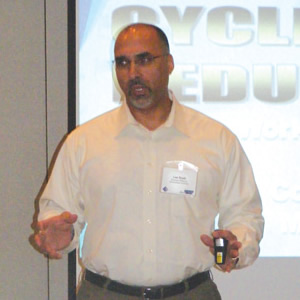 Lee Rush is not a theory guy and is happy to admit that. After nearly 20 years of managing body shops, including Sterling Autobody Centers and ABRA Auto Body & Glass, Rush learned that technicians don’t respond much to theory either. So he prefers a more real world, shop floor, “boots to the ground” approach when it comes to improving the operational process of a collision repair facility and coming up with a strategy to execute.
Lee Rush is not a theory guy and is happy to admit that. After nearly 20 years of managing body shops, including Sterling Autobody Centers and ABRA Auto Body & Glass, Rush learned that technicians don’t respond much to theory either. So he prefers a more real world, shop floor, “boots to the ground” approach when it comes to improving the operational process of a collision repair facility and coming up with a strategy to execute.
That’s the approach he communicated to the Sherwin-Williams A-Plus Network Vision Group Feb. 24 in Phoenix, Ariz., with the overall goal of reducing cycle time.
Rush, who is currently the strategic account manager, multiple shop operators (MSO)/auto auctions, for Sherwin-Williams, said his main job while managing those big MSOs was to “duplicate process if we decided something was a best practice.” And it was all about managing the “score,” not the sale – the score being comprised of daily productive units, labor hours per day and days per repair.
The key to processing repairs through a collision repair facility in the most time effective manner, Rush said, is to identify the “absolutes:”
• Categorize and schedule repairs.
• Perform express repair on “CAT 1” repairs (explained further down).
• Conduct a thorough damage analysis on every vehicle.
• Check all parts for correctness.
• Pre-assemble as many components as possible pre-refinish.
• Perform spray-out test panel.
• All reassembles are priority.
• Pre-detail all qualifying vehicles (which Rush says has been a “huge discovery” in MSO shops).
• Perform quality assurance inspections (frame, body, refinish, final).
• Final quality control and test drive every vehicle.
• Conduct release meetings daily.
• Stage all vehicles for delivery.
Rush said that all of these absolutes address the primary killers of cycle time: parts (missing, wrong, etc.), supplements, damage severity, quality, reassembly and communication.
According to Rush, repairs should be categorized as follows:
CAT 1: Single panel replacement (bolt on) or 5-hour or smaller metal repair.
CAT 2: Same as CAT 1, only a combination of single panel replacements and/or 5-hour or smaller metal repairs.
CAT 3: Single panel replacement (weld in) of 5-hour or larger metal repairs or mechanical.
CAT 4: Multi-panel replacement (weld in).
And Rush highly endorsed a “speed lane” for CAT 1 repairs.
“A speed lane gets CAT 1 repairs off the floor and opens up production,” he said. “It increases the efficiency of guys doing CAT 3 and 4 repairs.”
The point of all this? The MSOs are continually working on process efficiency to better their Key Performance Indicators, and single-store owners will have to do the same if they want to survive. Today, it’s all about the numbers.













